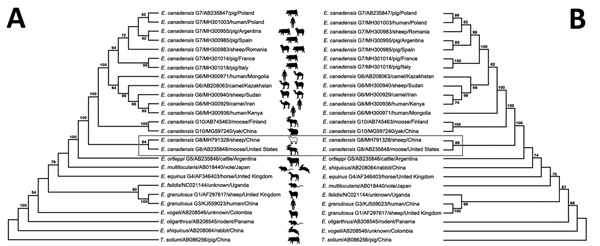Volume 25, Number 7—July 2019
Research Letter
Echinococcus canadensis G8 Tapeworm Infection in a Sheep, China, 2018
Figure

Figure. Phylogenetic analysis of Echinococcus species of different genotypes, strains, and host origins, including the E. canadensis G8 tapeworm identified in a sheep in China, 2018. Phylogenetic trees were inferred by maximum-likelihood analysis on the basis of concatenated amino acid data of 12 protein-coding genes by using the Jones-Taylor-Thornton model (A) and concatenated nucleotide data of 12 protein-coding genes by using the Tamura-Nei model (B) in MEGA7.0 (https://www.megasoftware.net). The reference species Taenia solium was used as the outgroup. We performed bootstrapping with 1,000 replicates to calculate the percentage reliability for each node in both data sets; only values of >50% are shown. Tree branch lengths are proportional to the evolutionary distance. The box contains the E. canadensis G8 tapeworm identified in this study (GenBank accession no. MH791328) and its closest relative from a moose in the United States (GenBank accession no. AB235848). Sheep shown in white represents a potential new intermediate host of E. canadensis G8.
1These authors contributed equally to this article.